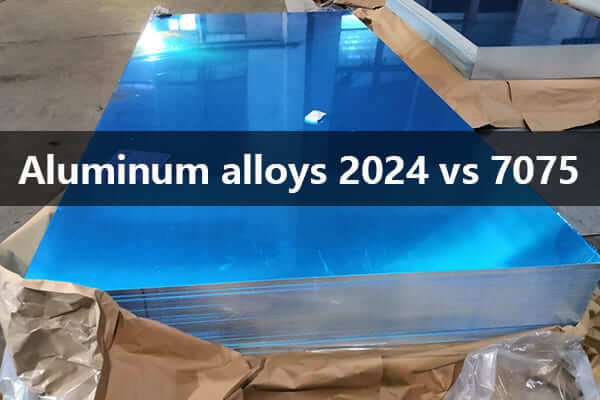Discover the key differences between aluminum alloys 2024 vs 7075. Learn their chemical composition, mechanical properties, and ideal applications in aerospace, automotive, and sports equipment.
In aerospace engineering, material choice drives weight, strength, reliability, and ultimately mission success. The clash between 2024 vs 7075 aluminum has spanned decades, but the conversation remains as relevant as ever in 2024 and beyond.
This article cuts through hype to deliver practical, data-driven insights about how “2024 vs 7075” perform in real-world aircraft structures, components, and fabrication workflows.
Expect a candid, user-centered look at properties, processing, costs, and design guidance you can apply today.

Aluminum alloys 2024 vs 7075
| Element | 2024 (Al-Cu-Mg) | 7075 (Al-Zn-Mg-Cu) |
| Aluminum (Al) | ~90.7–94.7% | ~87.1–91.4% |
| Copper (Cu) | 3.8–4.9% | 1.2–2.0% |
| Magnesium (Mg) | 1.2–1.8% | 2.1–2.9% |
| Manganese (Mn) | 0.3–0.9% | ≤0.3% |
| Zinc (Zn) | ≤0.25% | 5.1–6.1% |
| Iron (Fe) | ≤0.5% | ≤0.5% |
| Silicon (Si) | ≤0.5% | ≤0.4% |
| Chromium (Cr) | ≤0.10% | 0.18–0.28% |
| Titanium (Ti) | ≤0.15% | ≤0.2% |
| Other elements (each) | ≤0.05% | ≤0.05% |
| Other elements (total) | ≤0.15% | ≤0.15% |
7075 vs 2024 sit in the high-performance segment of aerospace aluminum, yet they serve different design philosophies.
The 2xxx family (2024) centers on copper-rich alloys known for excellent fatigue strength and favorable fracture behavior.
The 7xxx family (7075) emphasizes outstanding strength-to-weight, with toughness and stiffness that make it a favorite for load-bearing parts.
The temper designation—T6, T3, T351, and others—drives the final properties as heat treatment, aging, and stabilization processes tailor performance.
In the 2024 vs 7075 showdown, look for tradeoffs among strength, corrosion resistance, weldability, machinability, and fabrication method (riveted, welded, or bonded assemblies).

7075 aluminum for aircraft
Strength and stiffness define 7075-T6, making it the go-to choice for critical load paths where weight is non-negotiable.
When designing with 7075 aluminum, engineers often emphasize post-processing, coatings, or protective finishes to mitigate corrosion risks.
The alloy responds very well to aging (T6 temper), which locks in high strength but can reduce ductility.
In contrast, 2024 alloys (commonly 2024-T3 or 2024-T351) trade some ultimate strength for better toughness and fatigue properties, along with improved manufacturability in many scenarios.
The 2024 family shines in assemblies where reliability, corrosion tolerance, and ease of machining matter as much as, or more than, peak strength alone.
In the 2024 vs 7075 debate, this alloy often wins where longevity and maintainability trump sheer load capacity.
| Property | 7075-T6 (typical) | 2024-T3 / T351 (typical) |
| Yield Strength (MPa) | ~503 | ~345–400 |
| Ultimate Tensile Strength (MPa) | ~572 | ~470–490 |
| Density (g/cm3) | 2.81 | 2.78 |
| Corrosion Resistance | Poor without coatings | Moderate to good with proper protection |
| Weldability | Poor | Limited; specialized methods needed |
| Machinability | Good with proper tooling | Excellent; smooth cutting and long tool life |
| Fatigue Performance | High under ideal conditions | Strong, often better damage tolerance than very high-strength 7xxx alloys |
Note: Values vary with temper and heat treatment. Always consult the material supplier’s data sheet for the exact temper, composition, and processing guidelines for your application.
Choosing between 2024 vs 7075 is as much about fabrication as it is about in-service performance.
Common applications:
Common applications:
In the modern aerospace landscape, the ultimate choice between 2024 vs 7075 hinges on the mission profile, environmental exposure, production scale, and lifecycle costs.
Neither alloy is a universal answer; the best designs blend both to meet strict performance targets while keeping manufacturing practical and maintainable.
For teams facing the question of “2024 vs 7075,” the path to success lies in early material selection tied to real-world loads, corrosion exposure, fabrication routes, and a clear maintenance plan.
If you’re drafting an material selection brief or evaluating a new airframe component, start with a design requirement matrix that contrasts strength, fatigue, corrosion, and manufacturability.
Then map those requirements to either 7075 or 2024, or a hybrid approach that leverages the strengths of both.
The result is a safer, lighter, and more cost-effective aerospace solution tailored to your mission—your definitive answer to the ultimate 2024 vs 7075 decision.
Aluminum strip for transformer means that aluminum strip is used as conductive material in the high and low voltage windings of dry-type transformers and oil-immersed transformers.
Among the various aluminum alloys available, the 2014 aluminum plate has carved a niche for itself, particularly in applications demanding high strength, excellent machinability, and resistance to fatigue.
6061-T6 Aluminum floor plate, commonly known as “diamond plate” or “tread plate”, is an excellent candidate for most processing techniques and both interior and exterior applications.
1100 aluminum sheet is one of the representatives of the 1 series pure aluminum plate, and it is also the most widely used alloy.
Learn how non-stick aluminum foil works, its high-performance coatings, heat resistance, and benefits in food safety and sustainability. A must-read guide for chefs and manufacturers.
3105 Aluminum Sheet is adding some other elements on the basis of pure aluminum, such as cu, mg, si, mn, etc., the purpose is to improve the strength of aluminum alloy
No.52, Dongming Road, Zhengzhou, Henan, China
Henan Huawei Aluminum Co., Ltd, One Of The Biggest Aluminum Supplier In China Henan,We Are Established In 2001,And We Have rich experience in import and export and high quality aluminum products
Mon – Sat, 8AM – 5PM
Sunday: Closed
© Copyright © 2023 Henan Huawei Aluminium Co., Ltd
Latest Comments
Dear Sir, Please offer your best FOB Prices specs are as under ALUMINIUM STRIP (AL=99.50% MIN) SIZE:450 X32 X6 MM. DIN EN 570 EN-AW 1050 A, QUANTITY=3400KG
Hello, Would you be so kind to offer item as follows: Coil 0,6х1250 (1000)mm EN AW-3105 5tons
Hello, Can you offer me Aluminium plates? Actally I need: 110mm x 1700mm x 1700mm 5083 H111 - 21 pcs Next year planed is 177 pcs
Świetny artykuł. Byłem zachwycony, że wyszukałem ten artykuł. Wielu osobom wydaje się, że mają rzetelną wiedzę na ten temat, ale często tak nie jest. Stąd też moje miłe zaskoczenie. Jestem pod wrażeniem. Zdecydowanie będę rekomendował to miejsce i częściej wpadał, aby zobaczyć nowe rzeczy.
requirement of aluminium strip